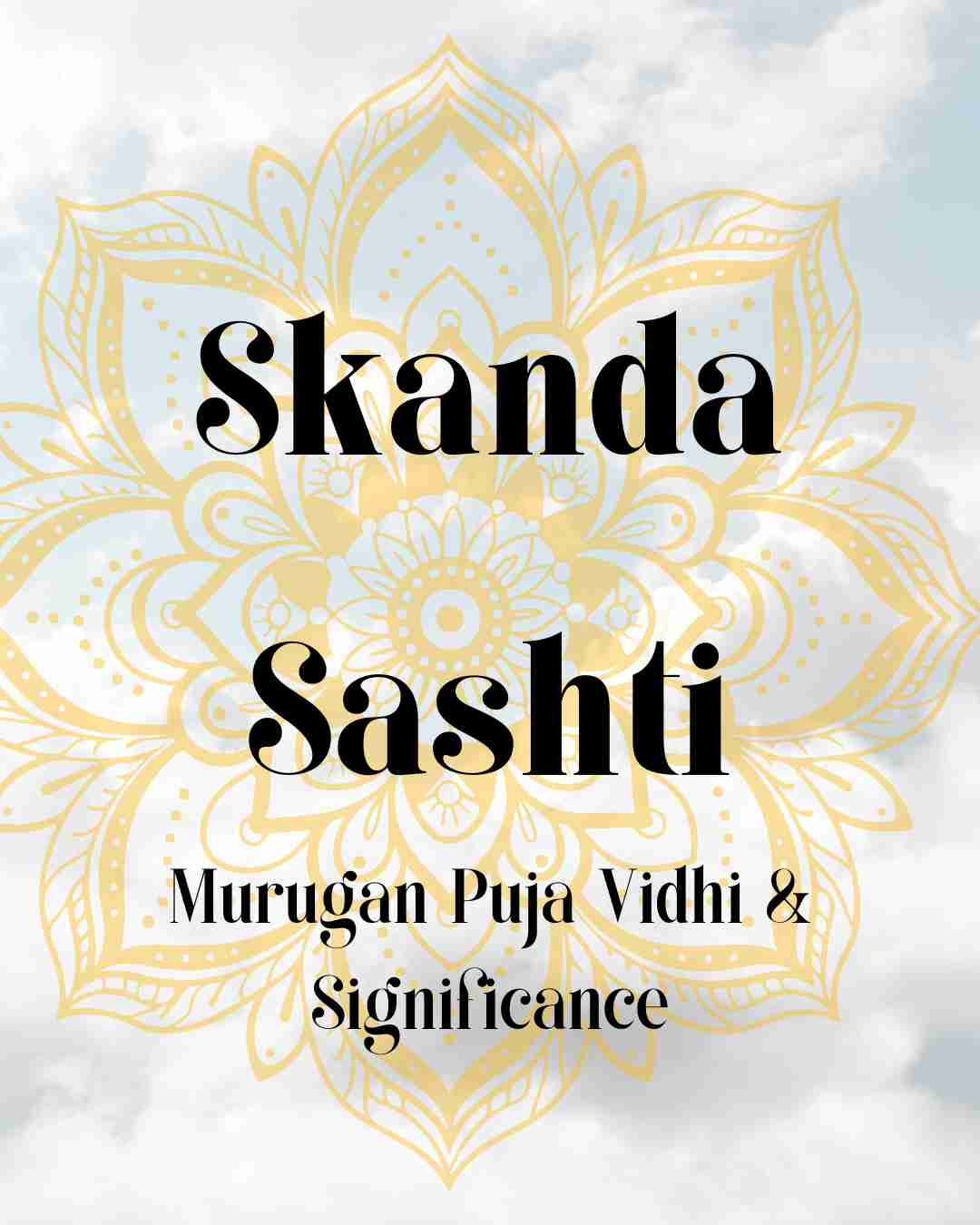Skanda Sashti 2025 is a profoundly sacred Hindu festival celebrated with great devotion by millions, especially in South India and Tamil Nadu. Dedicated to Lord Murugan—also known as Skanda, Kartikeya, or Subramanya—the warrior deity and son of Lord Shiva and Goddess Parvati, this festival symbolizes the divine victory of good over evil. It honors Lord Murugan’s legendary triumph over the demon Surapadman, a story that inspires devotees to nurture courage, righteousness, and spiritual strength.
This year, the most significant Skanda Sashti falls on October 27, 2025 (Monday), culminating in the grand event of Soora Samharam on October 28, marking Murugan’s victory over the evil forces. Skanda Sashti precedes the famous Navratri and Ayudha Puja festivals, weaving itself into the vibrant tapestry of autumn Hindu celebrations.
Also read- Festival in October 2025: Complete List of Hindu Festivals
What is Skanda Sashti?
Skanda Sashti is a monthly and annual Hindu observance dedicated primarily to Lord Murugan. The term “Skanda” refers to the divine warrior son of Shiva and Parvati, while “Sashti” refers to the sixth day of the lunar fortnight. The annual celebration of Skanda Sashti during the month of Aippasi (October-November) is the most prominent, especially in Tamil Nadu, marked by fasting, devotional singing, and temple festivals.
Murugan is revered as the god of war, victory, and wisdom who protects his devotees from evil forces and guides their spiritual journey. Skanda Sashti commemorates his heroic defeat of the demon Surapadman, symbolizing the destruction of ignorance and the triumph of light and virtue.
Skanda Sashti 2025 Date & Timings
In 2025, the key annual Skanda Sashti will be observed on:
- Skanda Sashti Date: Monday, 27th October 2025
- Tithi Begins: 6:04 AM on October 27
- Tithi Ends: 7:59 AM on October 28
The festival often stretches over six days of fasting and prayer leading to the climactic event known as Soora Samharam, celebrated in various temples with great pomp on October 28, 2025.
Read about – Mahalaya Amavasya 2025: Pitru Tarpan & Shraddha Rituals
Mythological Significance of Skanda Sashti
The story behind Skanda Sashti is narrated in several Hindu scriptures such as the Skanda Purana and Kanda Puranam. Its essence lies in the battle between Lord Murugan and the demon Surapadman, who was terrorizing the heavens and earth with his evil deeds.
- Surapadman was a powerful demon who oppressed the Devas (divine beings) and humans alike.
- The Devas prayed to Lord Shiva and Parvati, who manifested their son Murugan to defeat the demon.
- Murugan, armed with the divine spear (Vel), engaged in a fierce battle lasting six days—this period is observed as Skanda Sashti.
- On the sixth day, Murugan defeated Surapadman, restoring cosmic order and righteousness.
This victory symbolizes the eternal struggle between good and evil and the triumph of dharma (righteousness).
Spiritual Importance of Skanda Sashti
Skanda Sashti is a day to invoke courage, wisdom, and protection from Lord Murugan. Devotees fast and worship the deity to:
- Request Lord Murugan’s blessings for overcoming obstacles in life.
- Gain inner strength and fortitude to face challenges.
- Purify the mind and body through fasting and prayer.
- Receive protection from negative energies and malevolent forces.
- Cultivate humility, discipline, and spiritual fortitude.
The festival also reminds devotees of the importance of righteous living and divine grace in spiritual pursuits.
Puja Vidhi for Skanda Sashti 2025
To properly observe Skanda Sashti, devotees perform a structured puja involving rituals that appease Lord Murugan. Below is a detailed guide:
1. Preparation for Puja
- Wake up early and take a traditional bath to purify the body.
- Wear clean, preferably traditional attire.
- Clean and decorate the puja area with flowers, lamps, and incense.
- Set up a Murugan idol or picture with a silver or golden Vel if available.
2. Invocation and Sankalp
- Sit calmly and concentrate on Lord Murugan’s image.
- Take Sankalp aloud, stating your vow to observe the Skanda Sashti vrat and perform the puja sincerely.
3. Offering Abhishekam (Holy Bath)
- Perform Abhishekam to the Murugan idol or picture using water, milk, honey, sandalwood paste, and turmeric.
- While pouring these sacred substances, chant the powerful mantras:
- “Om Saravana Bhavaaya Namaha”
- “Om Velaya Namaha”
- Offer fresh flowers, Bilva leaves, fruits, and turmeric powder.
4. Chanting Mantras and Bhajans
- Recite the Kanda Sashti Kavasam, a sacred hymn dedicated to Lord Murugan, invoking his protection and grace.
- Sing devotional bhajans and hymns dedicated to Skanda.
- Meditate on Murugan’s heroic deeds and divine qualities.
5. Offering Naivedyam (Food Offering)
- Prepare traditional vegetarian offerings such as Kheer, fruits, coconut, and sweets.
- Offer these with folded hands, praying for Murugan’s blessings.
6. Arati and Conclusion
- Light ghee lamps and perform Arati with camphor.
- Offer prayers for peace, protection, and spiritual upliftment.
- Share Prasad with family and devotees.
Fasting Rules During Skanda Sashti
Fasting is a crucial part of the observance, symbolizing purification and devotion.
- Many devotees observe a strict fast, consuming only fruits, milk, and water throughout the day.
- Some observe Nirjala fasting (no food or water) from sunrise to the next day.
- The fast is broken only after the completion of the puja and Arati in the evening or next morning.
- It is advised to avoid onion, garlic, and non-vegetarian food during this period.
Soora Samharam: The Climax of Skanda Sashti
The Soora Samharam is the grand finale of the Skanda Sashti festival, celebrated on the sixth day of the lunar fortnight.
- It enacts the battle between Lord Murugan and Surapadman, symbolizing the destruction of evil.
- This event is staged in many temples, especially at Palani, Swamimalai, and other famous Murugan shrines.
- Devotees gather in large numbers to witness this symbolic victory, participate in processions, and receive blessings.
- The event fosters a deep collective spiritual energy and reaffirmation of faith in the divine.
Linkage with Navratri and Ayudha Puja
Skanda Sashti occurs in close proximity to Navratri and Ayudha Puja, forming an interconnected spiritual period in the Hindu calendar.
- Navratri celebrates the Divine Feminine in her various forms, especially Goddess Durga, representing power and victory over evil, paralleling Skanda Sashti’s theme of divine triumph.
- Ayudha Puja, observed towards the end of Navratri, involves worship of tools and weapons, symbolizing respect for the power that sustains life and victory—Murugan’s spear (Vel) is a divine weapon, aligning spiritually with Ayudha Puja’s significance.
Together these festivals embody the balance of cosmic forces—divine masculine and feminine, power, protection, and righteousness—encouraging devotees to invoke and embody these forces in their lives.
Read about – Masik Shivratri October 2025: Puja Vidhi & Night Fasting
Regional Celebrations of Skanda Sashti
Tamil Nadu
In Tamil Nadu, Skanda Sashti is a grand affair, especially at the Palani Murugan Temple, Tiruchendur, and Swamimalai. Elaborate rituals, fasting, cultural functions, and dramatized episodes of Soora Samharam are performed over six days.
Kerala
Known as Kandan Sashti, devotees fast and pray, and temples are beautifully decorated. The festival is celebrated with intricate rituals aligned with local traditions.
Karnataka and Andhra Pradesh
Popular Murugan temples witness large congregations. Devotional music, processions, and community feasts are common.
Other Regions
Skanda Sashti is also observed by Tamil communities worldwide, including Sri Lanka, Malaysia, and Singapore, maintaining its rich cultural ethos.
Read about – Valmiki Jayanti 2025: Life & Teachings of Maharishi Valmiki
Spiritual Mantras for Skanda Sashti
Devotees commonly chant:
- Kanda Sashti Kavasam: A protective hymn believed to safeguard from dangers.
- Om Saravana Bhava: A powerful mantra invoking Lord Murugan’s presence.
- Om Velaya Namaha: Reverence to the divine spear.
Repetition of mantras helps focus the mind and develop deep devotion.
Read about – Kojagari Lakshmi Puja 2025: Overnight Vigil & Wealth Rituals
Benefits of Observing Skanda Sashti
- Gains courage and strength to overcome personal challenges.
- Fosters purity of body and mind through fasting and prayer.
- Removes negative influences and brings protection.
- Invokes divine blessings for prosperity, health, and wisdom.
- Strengthens faith and connects devotees to ancient spiritual traditions.
Tips for Devotees Observing Skanda Sashti
- Begin preparations a day in advance—clean the home and puja area thoroughly.
- Take an early morning bath with sacred water, if possible from a holy river.
- Maintain a sattvic diet during the fast, avoiding processed and tamasic food.
- Spend time reading or listening to the story of Lord Murugan and Soora Samharam.
- Use Rudraksha malas or prayer beads to complement mantra chanting.
- Offer sincere prayers with faith and devotion for best results.
Skanda Sashti 2025 is not just a festival but a powerful spiritual journey for devotees of Lord Murugan. By observing the fasts, performing the puja vidhi, and participating in the celebration of Soora Samharam, devotees invoke divine blessings for courage, strength, and victory over evil forces in their lives. The festival’s close association with Navratri and Ayudha Puja adds further richness to the spiritual calendar, celebrating the synergy of divine energies.
May the blessings of Lord Murugan during Skanda Sashti 2025 illuminate the lives of all devotees with wisdom, protection, and inner strength.
Read about – Chhath Puja 2025 : Surya Arghya & Rituals


1 Comment